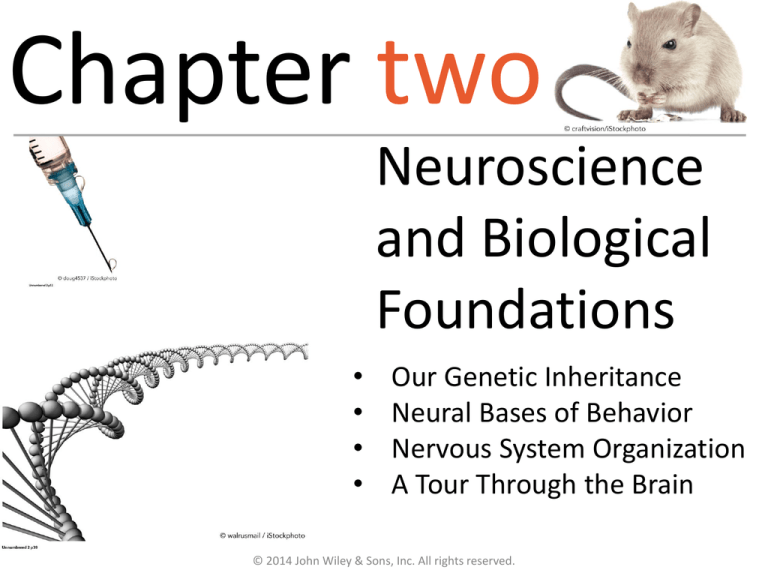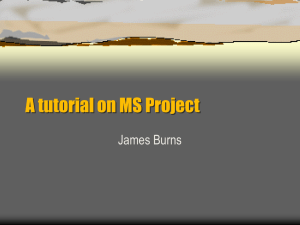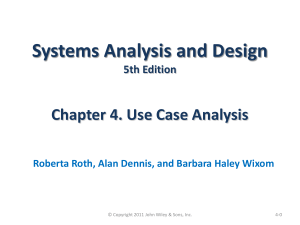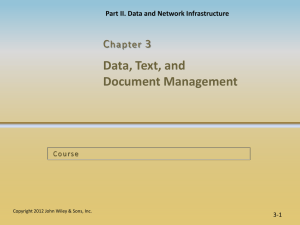
Chapter two
Neuroscience
and Biological
Foundations
•
•
•
•
Our Genetic Inheritance
Neural Bases of Behavior
Nervous System Organization
A Tour Through the Brain
© 2014 John Wiley & Sons, Inc. All rights reserved.
realworldpsychology
Things You’ll Learn in Chapter 2
Q1
Can our genes influence whom we vote for in
presidential elections?
Q2
Why can spending the first few months of life in
an orphanage lead to long-term problems in
cognitive functioning?
Q3
How can a chemical in the brain lead rats to
binge-eat M&Ms?
Q4
How can stem cell injections lead to restored
vision and improved recovery from strokes?
Q5
Why are former NFL athletes at increased risk of
depression, dementia, and suicide?
© 2014 John Wiley & Sons, Inc. All rights reserved.
OUR GENETIC INHERITANCE
© 2014 John Wiley & Sons, Inc. All rights reserved.
Behavior Genetics
• The study of how heredity and environment affect us
• Evolutionary psychology = the application of
principles of evolution to explain behavior and
mental processes
• Genes control the transmission of traits
• Modern research shows most human
Most serious
genetic disorders
characteristics are polygenic
are not
(controlled by multiple genes, not
transmitted by
merely one dominant or two
dominant genes.
recessive genes)
Why?
© 2014 John Wiley & Sons, Inc. All rights reserved.
realworldpsychology
• Most people understand that genes affect
our health, such as potential for heart
disease, diabetes, and cancer
• Genes also affect our personality traits,
behavioral habits, sexual orientation, and
psychological disorders
Q1
Can our genes influence whom we vote for in
presidential elections?
• Genes can even influence which political party we
side with, and our views on death penalty,
unemployment, and abortion (Hatemi & McDermott, 2012)
© 2014 John Wiley & Sons, Inc. All rights reserved.
Gene-Environment Interaction
• Environmental factors – both
physical and psychological – also
influence our characteristics
• Malnourished children may not
reach their full potential genetic
height or maximum intelligence
© 2014 John Wiley & Sons, Inc. All rights reserved.
Genes vs. Environment
• Identical twins share all their genes,
How can
fraternal twins share about half of their
psychologists
genes (just like non-twin siblings)
separate genetic
• Twins raised together by birth parents
causes from
share the same environment
environmental
• Identical twins should be more alike than
causes?
fraternal twins (such as in intelligence)
• Research on adoptive children can trace characteristics to
birth parents vs. adoptive parents
• Research shows many psychological traits (and disorders) run
in biological families
© 2014 John Wiley & Sons, Inc. All rights reserved.
Heritability
• Heritability = the percentage of variation in a
population attributable to heredity
– If no genetic influence, heritability would be 0%
– If no environmental influence, heritability would
be 100%
• Heritability does NOT apply to INDIVIDUALS
• Heritability does not trump environment
© 2014 John Wiley & Sons, Inc. All rights reserved.
Evolutionary Psychology
• Many behaviors emerged and still exist
because they helped our ancestors survive
• Natural selection = particular genetic trait
gives an organism a reproductive advantage
• “Reproduction of the fittest,” not “survival of
the fittest”
© 2014 John Wiley & Sons, Inc. All rights reserved.
NEURAL BASES OF BEHAVIOR
© 2014 John Wiley & Sons, Inc. All rights reserved.
The Basics
Building blocks of brain and nervous system:
• Neurons = responsible for receiving, processing, and
transmitting electrochemical information
• Glial cells = provide structure, nutrition and other
support to neurons
© 2014 John Wiley & Sons, Inc. All rights reserved.
Parts of a Neuron
• Dendrites = branching fibers that
receive impulses from other
neurons and send them to the cell
body
• Cell body = AKA soma, contains
cell nucleus
• Axon = long, tube-like structure
that sends impulses away from cell
body to other neurons (or to
muscles, glands)
© 2014 John Wiley & Sons, Inc. All rights reserved.
Action Potential
© 2014 John Wiley & Sons, Inc. All rights reserved.
Action Potential
• Sequence of depolarization and repolarization
moves the action potential from the cell body
to the axon terminal buttons like the “wave”
© 2014 John Wiley & Sons, Inc. All rights reserved.
Speed of Thought
• Electricity moves 36 million meters/second
• Nerve impulses move 10 meters/second
• Nerve impulses move 10x faster through
axons with myelin sheath
Q2
Why can spending the first few months of life in an
orphanage lead to long-term problems in cognitive
functioning?
• Social isolation during early weeks/months of
life (as for babies in orphanage) prevents
proper growth of myelin, leading to long-term
cognitive impairment
© 2014 John Wiley & Sons, Inc. All rights reserved.
Communication Between
• Communication WITHIN neuron is electrical,
but communication BETWEEN neurons is
chemical
• Sending neuron gets close to receiving neuron
at synaptic gap, where neurotransmitters
(chemicals) cross the gap to deliver the
message
© 2014 John Wiley & Sons, Inc. All rights reserved.
How Neurotransmitters Work
Reuptake
© 2014 John Wiley & Sons, Inc. All rights reserved.
Lock and Key
© 2014 John Wiley & Sons, Inc. All rights reserved.
Common Neurotransmitters
© 2014 John Wiley & Sons, Inc. All rights reserved.
Endorphins
• Common neurotransmitter elevate mood, reduce pain
• Opium-based drugs mimic the body’s natural
endorphins
Q3
How can a chemical in the brain lead rats
to binge-eat M&Ms?
• Endorphins affect memory,
learning, appetite, and sexual
activity. Rats injected with
endorphins ate 5% of their body
weight in M&Ms!
© 2014 John Wiley & Sons, Inc. All rights reserved.
Hormones & the Endocrine System
• Endocrine system = network of glands located
throughout the body that secretes hormones
into the bloodstream
• Neurons send messages to certain receptors;
hormone messages are carried by the blood to
any cell that will listen
• Regulates and maintains long-term body
processes, such as growth, sexual
characteristics, digestion, and elimination
• Controls response to emergencies: adrenal
glands release cortisol, epinephrine, and
norepinephrine
© 2014 John Wiley & Sons, Inc. All rights reserved.
NERVOUS SYSTEM
ORGANIZATION
© 2014 John Wiley & Sons, Inc. All rights reserved.
© 2014 John Wiley & Sons, Inc. All rights reserved.
Central Nervous System (CNS)
• CNS is powerful, but fragile
• Neuroplasticity = brain can reorganize its
functional structure due to usage and experience
How can stem cell injections lead to
restored vision and improved recovery
from strokes?
• Neurogenesis = lost cells can be replaced by neural
stem cells (rare immature cells that can migrate and
grow into any type of cell).
• No cell transplant for spinal cord injuries in
humans, but animal research shows stem cell
treatment leads to improvement in paralyzed limbs
Q4
© 2014 John Wiley & Sons, Inc. All rights reserved.
Spinal Cord
• Relays AND initiates vital information to other parts of
the body
• Reflexes = automatic behavior in response to stimuli
• Allows immediate action without delay of routing
through brain
What is the
evolutionary
benefit of the
reflex arc?
© 2014 John Wiley & Sons, Inc. All rights reserved.
Newborn Reflexes
A
B
C
Rooting reflex – Lightly stroke the cheek and
watch how the infant automatically
(reflexively) turns toward the stimulation and
attempts to suck
Grasping Reflex – Place your
finger or an object in the
infant’s palm and note the
automatic grasp
Babinski Reflex – Lightly stroke the sole
of the foot, and the big toe will move
toward the top, while the other toes fan
out.
© 2014 John Wiley & Sons, Inc. All rights reserved.
Peripheral Nervous System (PNS)
• The part of the nervous system outside the brain
and spinal cord
• Carries information to and from the CNS
• Links brain and spinal cord to body’s sense
receptors, muscles and glands
– Somatic nervous system (SNS): carries sensory
information to the brain and instructions back to
skeletal muscles
– Autonomic nervous system (ANS): responsible for
involuntary tasks like heart rate, digestion, and
breathing © 2014 John Wiley & Sons, Inc. All rights reserved.
Autonomic Nervous System
• Sympathetic division:
mobilizes energy to
respond to stressor (fight
or flight)
• Parasympathetic division:
calms body to conserve
energy, returns body to
normal functioning after
stress
© 2014 John Wiley & Sons, Inc. All rights reserved.
A TOUR THROUGH THE BRAIN
© 2014 John Wiley & Sons, Inc. All rights reserved.
Biological Tools for Research
© 2014 John Wiley & Sons, Inc. All rights reserved.
Biological Tools for Research (cont.)
© 2014 John Wiley & Sons, Inc. All rights reserved.
Forebrain
Limbic System – The
interconnected group of forebrain
structures involved with emotions,
drives, and memory, as well as
major physiological functions
Cerebral Cortex– The thin surface
layer that regulates most complex
behavior (i.e. sensations, motor
control).
© 2014 John Wiley & Sons, Inc. All rights reserved.
Limbic System
Hippocampus– Seahorse shaped
part of the limbic system involved
in forming and retrieving
memories
Amygdala– Part of the limbic
system that controls emotions, like
aggression and fear.
© 2014 John Wiley & Sons, Inc. All rights reserved.
realworldpsychology
• Cerebral cortex = surface layer of the brain
• Responsible for most complex behaviors and higher
mental processes
• Damage to cerebral cortex linked to substance abuse,
dementia, and suicide
Q5
Why are former NFL athletes at increased risk of
depression, dementia, and suicide?
• Trauma is particularly common in
contact sports, like football, ice hockey,
boxing, and soccer
© 2014 John Wiley & Sons, Inc. All rights reserved.
Lobes
© 2014 John Wiley & Sons, Inc. All rights reserved.
realworldpsychology
• In 1848, 25-year-old railroad worker
Phineas Gage had a metal rod
accidentally blown through the front of
his face, destroying much of his brain’s
frontal lobe
• Experienced drastic personality
changes; became impatient and lacked
concern for coworkers
• He eventually obtained a job driving a
stagecoach, which required high motor,
cognitive, and interpersonal skills
© 2014 John Wiley & Sons, Inc. All rights reserved.
What does modern
research about
neuroplasticity tell us
about Gage’s possible
recovery?
Two Brains in One?
• Each hemisphere controls the opposite
site of the body
• Corpus callosum = thick band of nerves,
connects the two hemispheres
• Although each side of the brain might
have a specialty (like Broca’s area for
speech in the left hemisphere), when
specific regions of the brain are injured
or destroyed their functions can be
assumed by neighboring region – or
even opposite hemisphere
© 2014 John Wiley & Sons, Inc. All rights reserved.
realworldpsychology
• Popular myth says left brain is analytical and
right brain manages creativity
• Research shows both hemispheres work
together in an integrated manner, like
teammates playing soccer; each area might
have specialties, but everyone knows what
the other is doing and can help when
needed
© 2014 John Wiley & Sons, Inc. All rights reserved.
© 2014 John Wiley & Sons, Inc. All rights reserved.









